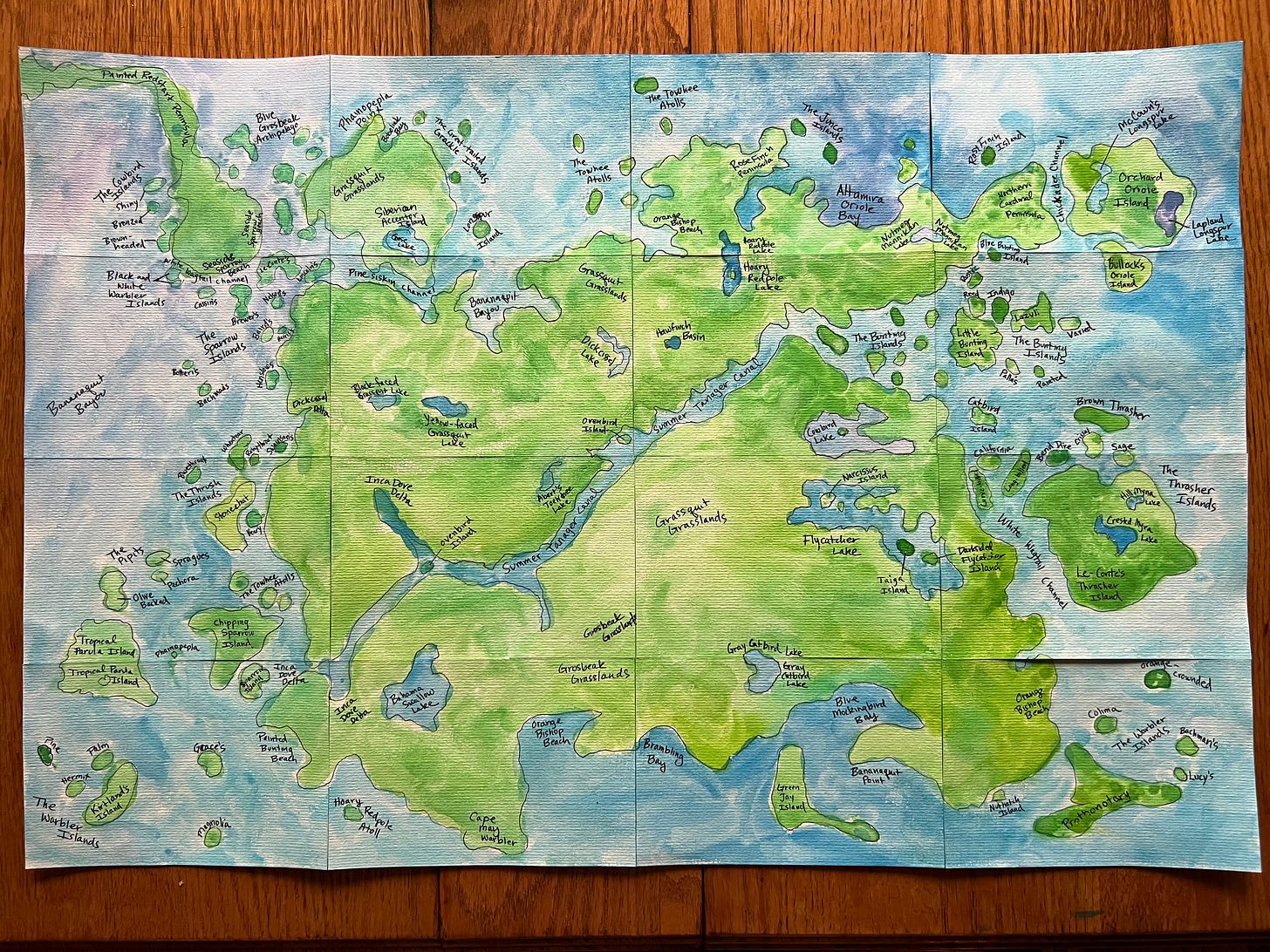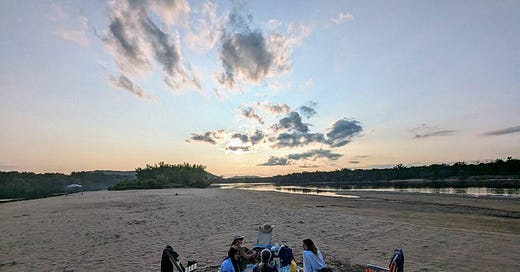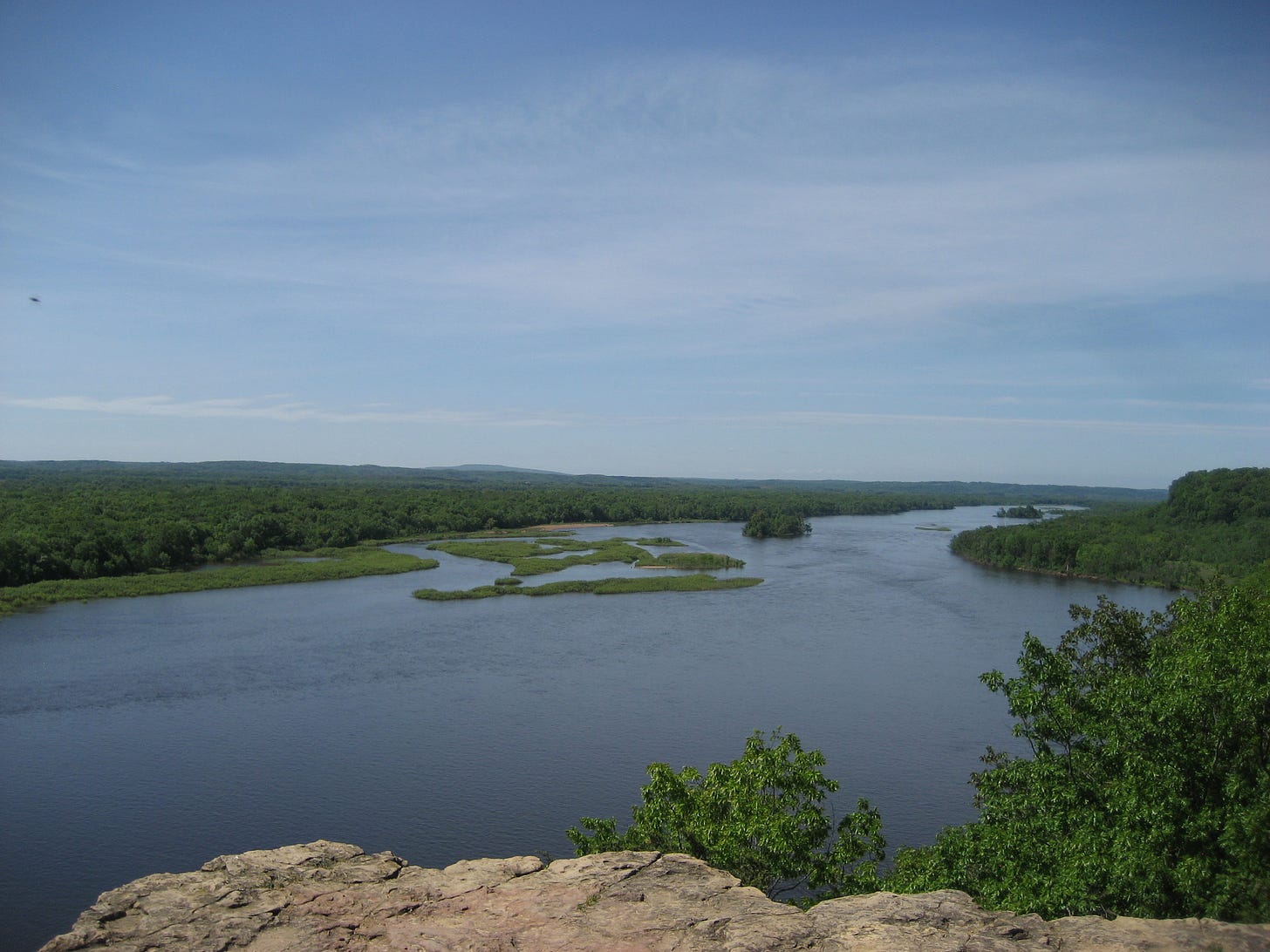Earlier this summer, I was gathered on a sandbar at sunset with a handful of beloved girlfriends.
The landscape in this part of the Lower Wisconsin Riverway is wide open. The sun had just dropped behind what my daughters used to imagine as Fairy bluff.
We were all giddy in the summer glow, surprising ourselves by slipping into bird talk. There was a gaggle of white ibises in the shallow waters that were stunningly beautiful against the lush, summer palette of greens. Then we became mesmerized by all the blue herons. We started scanning the sky, talking about the artistry of pelicans in flight and the bluffs on the western horizon, where eagles build enormous roosts and raise their babies.
When did we all become bird lovers?
Some of us mothers and grandmothers, all of us riding the vagaries of mid-life, here we were gushing and excited. None of us claimed any knowledge or called ourselves birders. This contagious excitement had crept in from the corner, shifting the shape of our conversation. I was reminded of Terry Tempest William’s poetic memoir, “When Women Were Birds.”
To know the magnetic pull
I’ve been returning seasonally to this same spot on the map for more than two decades, like a bird loyal to her nesting grounds. I know this landscape of slow-water and shifting-sands like my own body. Like my body, it changes all the time.
I didn’t grow up here, but I have grown up here. Is it pretentious to call it my spirit home?
I am mystified by this place. Why do I find it to be the most beautiful place I’ve ever been?
The magnetic geography that governs migration continues to mystify the human brain.
I feel grateful to have a place to return to, a place where I feel safe, content, most like myself. It is here, near fresh water that is tinted like tea, that I feel most connected to the flow of life. The movement is constant and calming, 420 miles of river joining with the powerful Mississippi to the west, then merging into the Atlantic ocean at the Gulf of Mexico.
This is a humble river with global connections.
Here, in this calm spot, I have told my children old stories, stories that seem to make perfect sense in this landscape. I have told them Robin Wall Kimmerer’s version of Sky Woman Falling repeatedly in hopes they will remember it, viscerally.
“A mother and daughter are an edge. When I stand on the edge of the land and sea, I feel this tension, this fluid line of transition.”
-Terry Tempest Williams, from WHEN WOMEN WERE BIRDS
Not far from here, as the crow flies, is the International Crane Foundation. There you can see all of the world’s crane species living in settings that presumably resemble their homelands, but on 300 acres in the midwest.
One Mother’s Day a few years ago, my mom and daughters and I spent a few hours wandering the exhibits and marveling at the large birds. Most are exotic to us, but the Sandhill Crane is our local regular. Once near extinction in Wisconsin, they are common now, with mating pairs returning annually to unlikely spots near our home in the city. Almost four feet tall, a dramatic but gangly pair crosses the street on stick-skinny legs and wanders around the parking lot of the YMCA where my daughter swims. Their croaky calls can travel over two and a half miles.
When I hear Sandhill Crane bugles vibrate over the Wisconsin River, it’s easy to remember that we are living where mastodons once roamed.
Exiting the Crane Foundation’s gift shop with my mother and daughters, I wondered for the first time, Should I buy a bird guide?
Is this what growing up feels like?
Am I becoming a bird lady?
Is it inevitable?
I shared photos from our Mother’s Day outing on Facebook and one of my mom’s friends from High School messaged me directly. Her comment was brief: Please pass along my greeting to your mother (we called her 'Bird' in high school).
I was unaware of my mother’s nickname. My own beak-like nose and lanky build come from my father’s side of the family. When a former boyfriend once suggested that I looked like a bird, I didn’t know if it was a compliment. Likewise, my mother is a little confused by her former classmate’s comment. She doesn’t remember people calling her Bird.
But I remind her that her mother, my grandma, had a teal-colored parakeet named Clifford and was dedicated to the birdfeeders in her backyard.
When I think of my grandma, who died when I was eleven, I picture her crown of pure white hair. She had a soft lap and seemingly infinite time to cozy with me on the couch. The floral wool fabric of her sofa was a little scratchy but we’d sit there with her calico cat and color. Starting with a blank sheet of paper, she’d draw a flowing, fluid line that swirled and criss-crossed around the page. The amorphous shape opened up blocks of space that we worked together to fill with bold hues, our heads leaned in over the project. She pressed hard with the crayons and her breath smelled of coffee, which neither of my parents drank.
A baseball game was always on the radio in the background. Grandma loved Johnny Bench and had taught Clifford to screech “Rally Round the Reds” when anyone walked into the kitchen.
I was pregnant with my second child when I suggested to my mom, over the phone, without much thought, that she move to be closer to us. I believe she started packing boxes that evening. She moved into a rental just a block away, building memories with my young daughters that still come easily to the surface for her, stories from a time when my own brain was an unreliable milky-mush. Then once a month she’d throw a suitcase and some road snacks in the car for the eight hour drive, each way, to visit her elderly father.
I never heard her complain about the drive or the responsibility. On the contrary, she came home talking about how much fun she’d had goofing around with her dad’s friends over long card games. She described him as dear.
My mother’s role, aside from delivering frozen meals and playing cards, was to make sure Grandpa had a stock of bird food in the basement to get him, and the birds, through the winter. Grandpa got antsy in the winter.
My mother sat with her dad at the kitchen table watching the backyard regulars - cardinals, chickadees, finches - while he listened to the Reds game on the radio. After some foul play, either from the squirrels or the rival team, he’d declare it was time to “shake up the blubber” and push back from the table. He kept his plaid, woolen newsboy on a shelf by the front door and they’d head out together for a brisk walk through the neighborhood. In my mother’s recountings, she always claimed that she could barely keep up with his vigorous pace.
My mother will do anything for the people she loves and enjoy doing it. I’ve spent my whole life knowing her loyalty and care were non-negotiable, unconditional, and infinite. While her loyalty has not weakened, her ability to be helpful is uncertain as her memory wavers. I must be the helper, and I’m fumbling. I worry it’s not a superpower I’ve inherited. Her heart was always big enough for both of us.
I wonder if birds are part of the medicine we both need.
“Humans have looked to birds as literal messengers and have used the patterns and movement of birds as divination.”
-Chanti Tacoronte-Perez, from BIRDSONG ORACLE
In late August, I was again at my favorite spot on the Wisconsin River, this time spending a week at the cabin we rent. Days at the cabin are for rest, reading, regrounding, and watching the birds. I took along a book I was looking forward to reading called “Birding to Change the World.” The recommendation came from Substacker
who writes about matters of kinship. Not just the title intrigued me. Much of the narrative unfolds at an urban park near my house.From the book, I learned some really neat things about birds that are probably basic. But I wonder, does everyone know that birds breath through their bones?! Or that songbirds can sing two entirely different songs at the same time? This is because they have ‘instruments’ in their chests that Trish O’Kane describes as a ‘double-barreled box of cartilage’ and a ‘resonating chamber with elastic vibrating membranes.’
I was completely captivated by O’Kane’s memoir, a beautiful story of compassion, joy, and frustration.
These feelings are illustrated in the cards I happened to pull from BIRDSONG, a deck of cards from the artist Chanti Tacoronte-Perez, when I was writing this post. They are the words I was looking for, words for feelings that are so familiar.
I am a bird lady becoming
“Avians have probably been teaching our species for the estimated half a million years that we’ve been on the planet. We may have learned to build our own nests, weave, sing, and group together…all from our feathered friends.”
- Trish O’Kane, from BIRDING TO CHANGE THE WORLD
When I finished O’Kane’s book, I looked up songbirds in the field guide that sits on a shelf at the cabin. Their names are wonderful and wacky, or sometimes just descriptive and boring. I doubt I’ll ever be memorizing names and facts, but my daughter and I decided to make a big ‘fantasy rice map’ with watercolors, then to label the landscape using the songbird names. Our kind of birding.
In my fantasy, going birding means wandering to delightful places like Bananaquit Bayou, White Wagtail Channel, Phainopepla Point, and the Great-Tailed Grackle Islands.
Like ‘my’ spot on the river, it’s a place to feel connected to the flow of life, to feel content, to feel beautiful, to feel safe. To be a bird lady.

Grateful to be part of a lineage of bird people. And ready to keep wandering the mysterious geography that is mid-life.
Thanks for being here! Please hit the ❤️ and tell me if you are a bird lady, too.










Jessica, I’m sending this to Trish! I interviewed her last Friday for Matters of Kinship.
I love your work. Thanks for the mention.🌱🌿💚
Love this post, and yes to unintentionally becoming a bird lady!